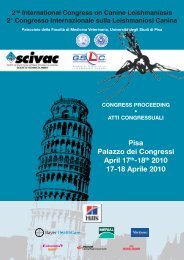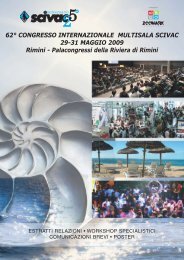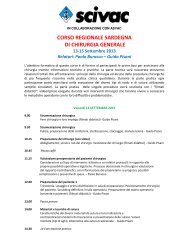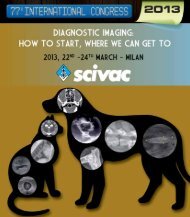58° Congresso Nazionale SCIVAC: Oncologia veterinaria
58° Congresso Nazionale SCIVAC: Oncologia veterinaria
58° Congresso Nazionale SCIVAC: Oncologia veterinaria
Create successful ePaper yourself
Turn your PDF publications into a flip-book with our unique Google optimized e-Paper software.
58° <strong>Congresso</strong> <strong>Nazionale</strong> <strong>SCIVAC</strong> • Milano, 7-9 Marzo 2008 • <strong>Oncologia</strong> <strong>veterinaria</strong> - Alle soglie del III Millennio<br />
peratoria (controllo e sopravvivenza a cinque anni in circa 75%) 23 . In alternativa,<br />
se è ovvio che non è possibile avere margini puliti oppure se dopo la chirurgia<br />
il tumore resta ancora macroscopico, una radioterapia curativa può anche<br />
essere effettuata in modo preoperatorio. Ci sono report di medicina umana<br />
che indicano che la probabilità/ rischio di avere complicazioni di cicatrizzazione<br />
sono più alti con la radioterapia preoperatoria.<br />
I sarcomi iniettivi dei gatti sono molto aggressivi localmente e anche se la<br />
chirurgia ha margini puliti istologicamente, una radioterapia curativa deve essere<br />
sempre considerata, poiché con sola chirurgia ad ampi margini il tasso di<br />
recidiva è del 50%. Se adiuvato a RT curativa, il tasso di recidiva scende a<br />
28% 24 . Rimane comunque un caposaldo che la prima chirurgia sia molto aggressiva,<br />
a margini puliti, visto che le recidive hanno sempre una prognosi<br />
peggiore rispetto al tumore primario.<br />
Altri tumori in cui la radioterapia è efficace sono: l’adenocarcinoma dei<br />
sacchi anali, l’adenocarcinoma perianale, il carcinoma della tiroide, il linfoma<br />
localizzato (vedi tumori intranasali).<br />
Indicazioni non neoplastiche in cui la radioterapia può essere utilizzata sono<br />
l’artrosi nel cane, gli eczemi (da leccamento), stomatite/gengivite del gatto<br />
e sialocele. Per queste lesioni benigne la dose utilizzata è molto più bassa.<br />
Bibliografia<br />
1. Pommer A (1958): X-ray therapy in veterinary medicine. Advances in veterinary science. Volume IV.<br />
Academic Press Inc., Publishers New York and London.<br />
2. Gillette EL (1987): Principles of radiation therapy. In: Theilen GH, Madewell BR (Hrsg.): Veterinary<br />
Cancer Medicine. 2. Aufl., Philadelphia, Lea & Febiger, 137-143.<br />
3. Théon AP, Rodriguez C, Griffey S et al: Analysis of prognostic factors and patterns of failure in dogs<br />
with periodontal tumors treated with megavoltage irradiation, J Am Vet Med Assoc 210: 785, 1997.<br />
4. Théon AP, Rodriguez C, Madewell BR: Analysis of prognostic factors and patterns of failure in dogs<br />
with malignant oral tumors treated with megavoltage irradiation, J Am Vet Med Assoc 210: 778, 1997.<br />
5. Bateman KE, Catton PA, Pennock PW,et al: Radiation therapy for the treatment of canine oral melanoma,<br />
J Vet Intern Med 8: 267, 1994.<br />
6. Blackwood L, Dobson JM: Radiotherapy of oral malignant melanomas in dogs, J Am Vet Med Assoc<br />
209: 98, 1996.<br />
7. Proulx DR, Ruslander DM, Dodge RK et al: A retrospective analysis of 140 dogs with oral melanoma<br />
treated with external beam radiation, Vet Radiol Ultrasound 44: 352, 2003.<br />
8. Théon AP, Madewell BR, Harb MF et al: Megavoltage irradiation of neoplasms of the nasal and paranasal<br />
cavities in 77 dogs, J Am Vet Med Assoc 202: 1469-1475, 1993.<br />
9. Adams WM, Bjorling DE, McAnulty JF et al: Outcome of accelerated radiotherapy alone or accelerated<br />
radiotherapy followed by exenteration of the nasal cavity in dogs with intranasal neoplasia: 53<br />
cases (1990-2002), J Am Vet Med Assoc 277: 936-941, 2005.<br />
10. Théon AP, Peaston AE, Madewell BR, et al: Irradiation of nonlymphoproliferative neoplasms of the<br />
nasal cavity and paranasal sinuses in 16 cats, J Am Vet Med Assoc 204: 78-83, 1994.<br />
11. Elmslie RE, Ogilvie GK, Gillette EL et al: Radiotherapy with and without chemotherapy for localized<br />
lymphoma in 10 cats, Vet Radiol 32: 277-280, 1991.<br />
12. Sfiligoi G, Théon AP, Kent MS: Response of nineteen cats with nasal lymphoma to radiation therapy<br />
and chemotherapy, Vet Radiol Ultrasound 48 (4): 388-393, 2007.<br />
38
















